Praying Mantis
The mantis can turn its head 180 degrees.
Advertisement
Praying Mantis Scientific Classification
Read our Complete Guide to Classification of Animals.
Praying Mantis Conservation Status
Praying Mantis Facts
- Prey
- Anything it can handle including crickets, mosquitoes, grasshoppers, moths, small vertebrates such as lizards and frogs and other mantises. Really big mantises even take hummingbirds.
- Name Of Young
- Nymph
- Group Behavior
- Solitary
- Fun Fact
- The mantis can turn its head 180 degrees.
- Estimated Population Size
- In the millions at least. Most are of least concern though the European mantis’ status is endangered in Germany.
- Biggest Threat
- Predators
- Most Distinctive Feature
- Their raptorial arms, which are held in the prayerful position that gives the insect its name.
- Gestation Period
- 11 days
- Litter Size
- 100 to 600
- Habitat
- Grassland, tropical rainforests, meadows, deserts, gardens
- Predators
- Snakes, spiders, lizards, bats, birds, small mammals
- Diet
- Carnivore
- Type
- Insect
- Common Name
- Praying mantis
- Location
- Africa, Asia, Europe, North America
View all of the Praying Mantis images!
“The Praying Mantis can be described as creepy but useful”
“Praying mantis” is a term of art. All mantises or mantids belong to the Mantodea order, which has 2400 species. Some of them are not considered praying mantises, even though all mantises have raptorial forelegs that they use to snatch their prey. The European mantis, Mantis religiosa is considered the standard praying mantis, especially in Europe, but not every insect in the Mantis genus is considered “prayerful.” Indeed, the mantises Stagmomantis carolina and Tenodera aridifolia sinensis are also considered praying mantises and are the ones most commonly found in North America. Here’s more information about praying mantises.
5 Incredible Praying Mantis Facts!
Here are five facts about praying mantises.
- Some people keep them as pets.
- Mantises can change color, but the color change seems mediated by the temperature. Brown mantises exposed to warm sunlight turn green.
- The Carolina mantis, Stagmomantis carolina is South Carolina’s state insect.
- Mantises don’t like to move around much, and they wait for their prey to come to them. Some spend their entire life cycle on a single plant.
- Females create an ootheca, a case that protects their eggs from foam formed in their bodies. When it hardens it looks and feels like styrofoam.
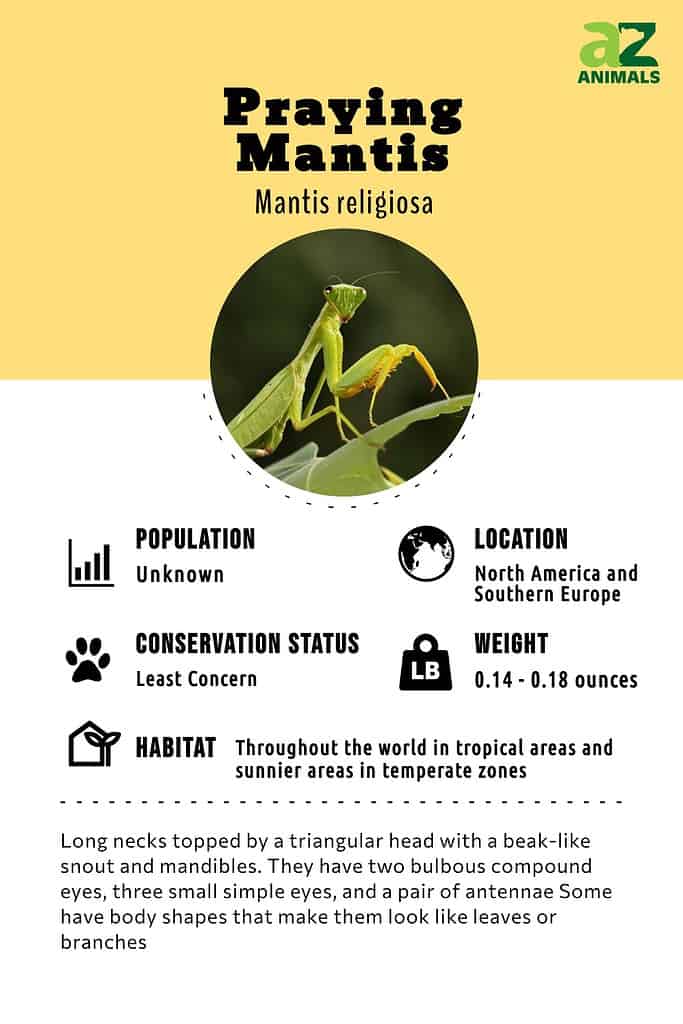
Scientific Name
The praying mantis belongs to the order Mantodea. name mantis comes from the Greek word for “prophet” and religiosa refers to the insect’s prayer-like look when its forelegs are raised. The carolina in Stagmomantis carolina means that the insect is found in the Carolinas. With Tenodera aridifolia sinensis, tenodera is Greek for “slender neck” and aridifolia means “dry leaf” in Latin. Sinensis means the insect comes from China. T. aridifolia sinensis is also one of the largest mantids.
Evolution And Origin
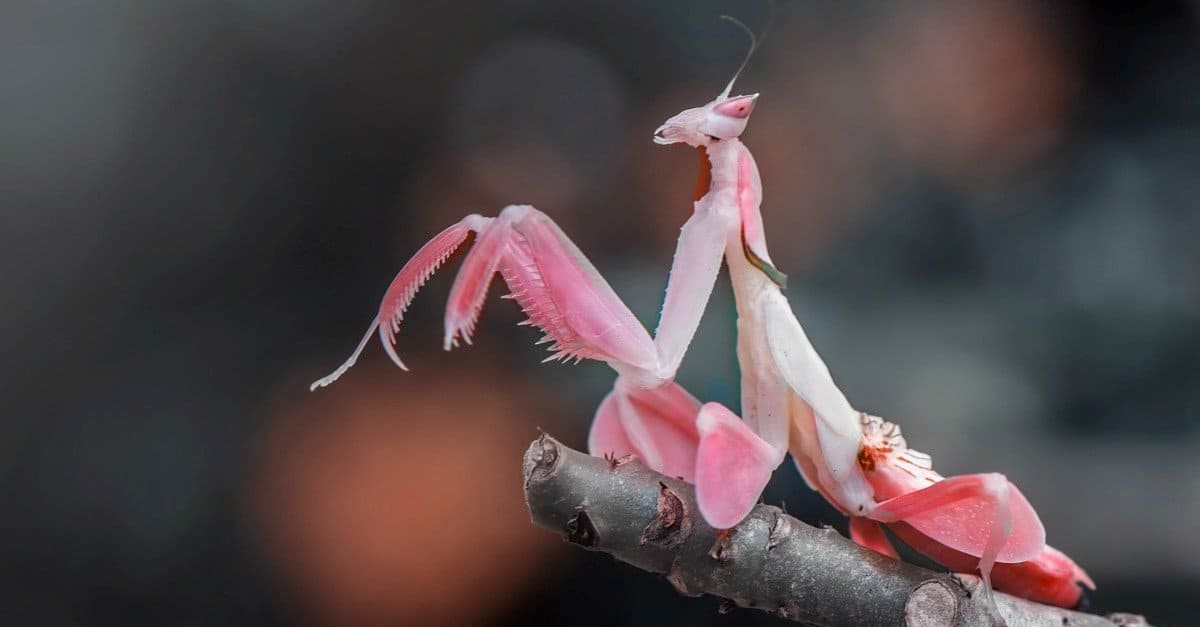
The praying mantis can be traced back to the Jurassic and Crustaceous eras.
©Galuh M/Shutterstock.com
The praying mantis is estimated to have begun at the begging of the Jurassic era, about 201 million years ago. The current praying mantises most likely commenced in the early Crustaceous period, around 145 million years ago, on what was then the supercontinent of Gondwanaland. When South America separated from Africa, the major divergence of modern mantises occurred. An early mantis fossil of Santanmantis axelrodi, an extinct genus of mantises, is one of the most primitive lineages of this insect.
Types Of
As a member of the family Mantodea, the praying mantis has over 2400 classified species and 15 different subfamilies. There are 21 species of mantis in the Stagmomantis genus, 16 in the Tenodera genus, and nine species in the Mantis genus. Here are a few of the Mantis genera:
- Mantis Octospilota
- Mantis Macrocephala
- Mantis Macroalata
Appearance
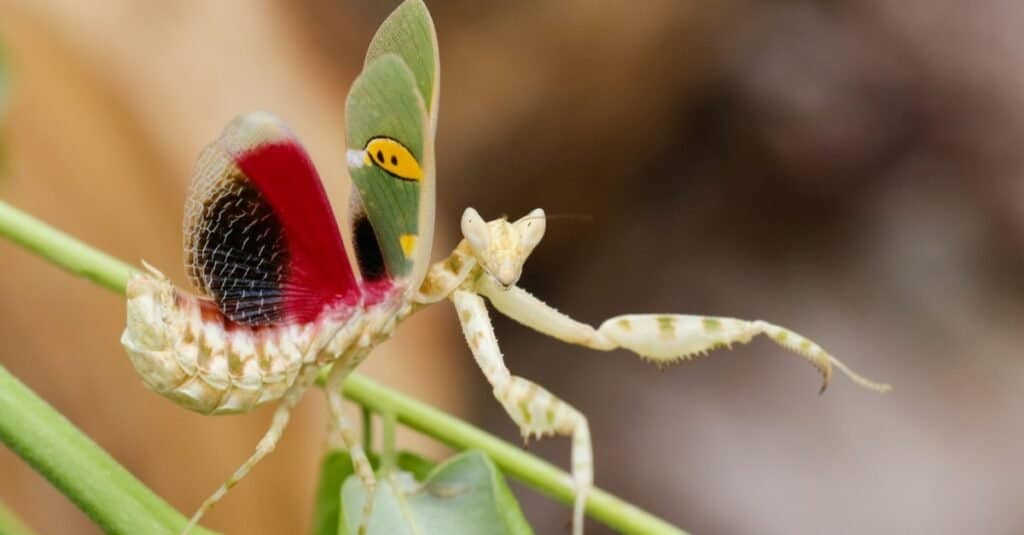
©SemilirBanyu/Shutterstock.com
The praying mantis is unmistakable. It has a long body with a triangular head that can move 180 degrees. Its antennae are also long and wiry, and its color can range from green to brown. Its compound eyes are huge. Like most insects, it has two pairs of wings and six legs, though the first pair has evolved into folding “arms” that can grab prey. Spines on the arms hold the prey in place while the mantis eats it. Males are smaller and slimmer than females and sometimes take flight at night.
The European mantis is unique because it has an ear on its belly between its last pair of legs. Unlike other insects, it is a real ear as opposed to an organ that can pick up sound waves.
Behavior
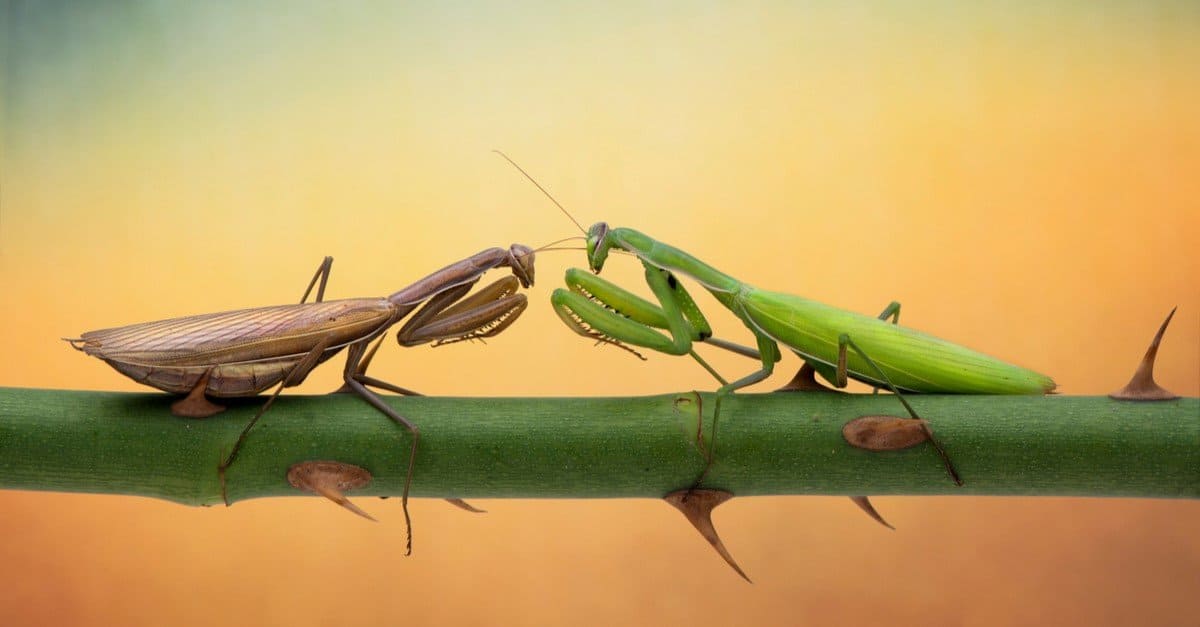
Despite its ferocity as a hunter, the mantis is a small and nonvenomous creature.
©Stefan Csontos/Shutterstock.com
Like all mantids, the praying mantis was built to be a very efficient predator. It finds its prey through sight and smell. It utilizes a “sit and wait” approach to hunting and will sit for a very long time on a plant before something comes along that it can grab. When prey comes within reach, it lunges and snatches it with its arms. The spines on the arms make sure that the insect has a firm grip. It does not employ a merciful kill bite and won’t wait till the prey is dead before it starts to feed. Mantises are even able to spear a bug in flight. Females are notorious for practicing sexual cannibalism now and then.
Mantises don’t fly in order to hunt but simply get from one perch to another more quickly. Females can be so heavy that they can’t take flight at all. Praying mantises are solitary and only come together for mating.
Despite its ferocity as a hunter, the mantis is a small and nonvenomous animal. When faced with its own predator it will rise up and flash its wings, which often have eyespots that startle its attacker.
Habitat
These insects are found in habitats where there are lots of flowering plants and thus lots of prey. They are not found in areas where winters are long and bitter.
Diet
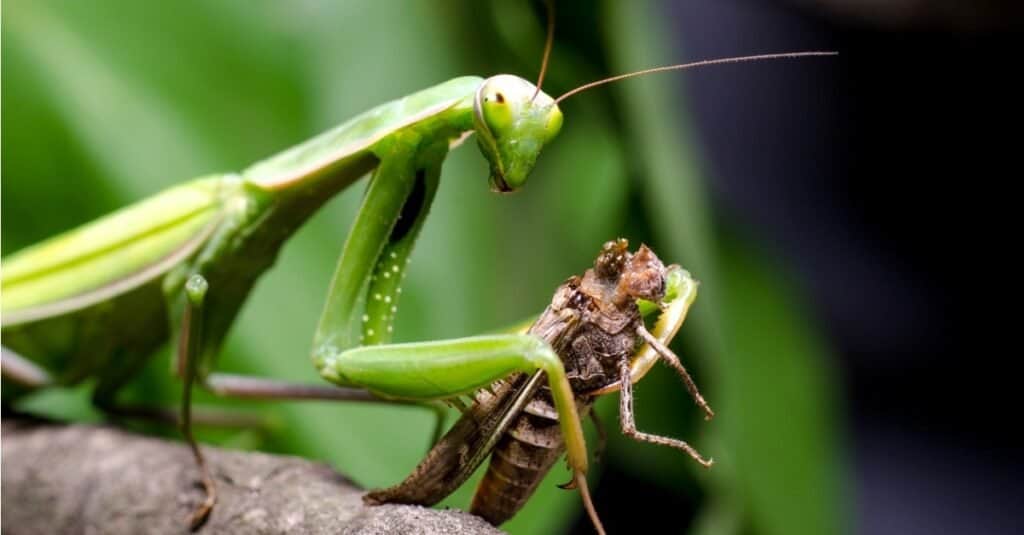
Praying Mantis, Mantis religiosa, eating a grasshopper.
©iStock.com/artas
Praying mantises are generalists, which means they’ll eat anything they can handle. This includes other insects such as its distant cousin the cockroach. Ants are one of the few insects the mantis will chase after, but they most often wait for prey to come to them. The largest of the Chinese mantises, T. aridifolia sinensis can actually take hummingbirds.
Predators And Threats
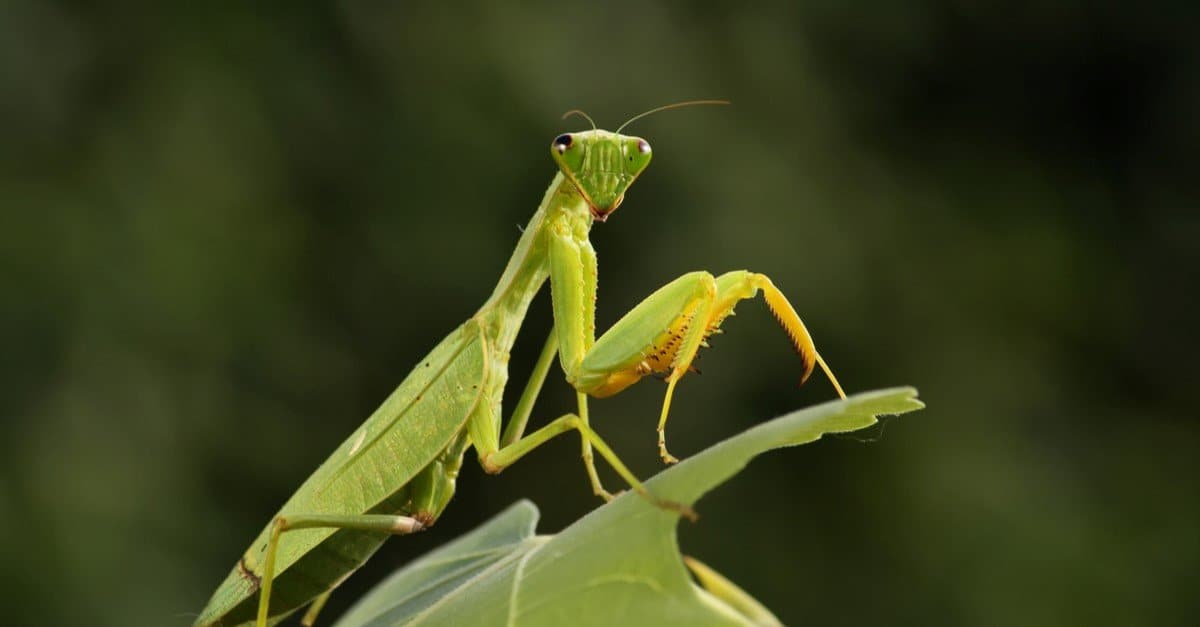
Giant African mantis is a hardy insect with few diseases or parasites.
©Karel Bartik/Shutterstock.com
Any animal in the area that has insects as part of its diet preys on the praying mantis. This includes spiders, snakes, lizards, primates, birds, frogs, toads, rodents, bats, other small mammals, and even the murder hornet. The mantis itself is a hardy creature, with few diseases or parasites. It is prized by gardeners as it eats insect pests. Granted, it will eat beneficial insects as well, but its usefulness as an agent of pest control makes up for it.
Reproduction And Life Cycle

Praying mantis nymphs hatching from an ootheca.
©iStock.com/Akchamczuk
Reports of female praying mantises killing and eating their mates are exaggerated even though it does happen. Why should she not eat him? It takes a lot of energy to produce eggs, and he’s the largest prey that’s easy to catch. With that in mind, the male mantis approaches the female with great caution during the mating season. It can take him hours of stop-and-start moving before he’s close enough to jump on her back, use his “arms” to hold her still and mate with her. When it’s over after a few hours he lets go and drops to the ground to get away from her before she can turn around and kill him. Mating usually takes place in late summer or early fall.
Mantis eggs overwinter and won’t hatch until spring, but before that the female creates an ootheca to protect her eggs. This is a capsule that’s made out of foam her body produces that hardens much like attic insulation. She lays 100 to 600 eggs in the capsule and then places it in a place that’s warm and sunny but still moist enough to keep it from drying out. If she has managed to kill and eat her mate, she produces more eggs and egg cases.
After overwintering, the babies hatch. At first, they look like tiny maggots, but they molt soon after they’re born into a form that resembles their parents, though much smaller. Mantis babies molt about 6 or more times before they’re fully grown, and there are about two weeks between molts. Females probably have more molts because they’re bigger.
The lifespan of a praying mantis is about nine months to a year, especially in a warm climate. Their lifespan is longer in captivity.
Population
Praying mantises are common and abundant insects around the world. They have no special status on the IUCN Red List or other lists.
View all 192 animals that start with PPraying Mantis FAQs (Frequently Asked Questions)
Are praying mantises carnivores, herbivores, or omnivores?
Praying mantises are carnivores that eat any animal that they can tackle. They will even eat each other.
Where do praying mantises live?
They live in warm and temperate areas where prey is abundant.
What do praying mantises eat?
They eat other insects, including grasshoppers, bees, flies, cockroaches and moths, spiders, and even small vertebrates.
How long do praying mantises live?
The life cycle of a praying mantis lasts about a year in the wild though most don’t live that long due to predation or the onset of winter.
Do praying mantises bite?
They can bite if they are annoyed and pinch with their forelegs, but they are usually peaceable around humans.
What is praying mantis good for?
Praying mantises are excellent at getting rid of insect pests.
Praying Mantis vs Hummingbird: Who Would Win in a Fight?
A praying mantis would win a fight against a hummingbird. Although it might seem completely counterintuitive to have a bug capable of killing a bird, the fact remains that hummingbirds are ill-suited to killing other creatures.
Who would win a fight between a black widow and a praying mantis?
A fully grown praying mantis would win a fight against a fully grown black widow.
What is the difference between a male and a female praying mantis?
The most significant difference between a male praying mantis and a female praying mantis is their abdominal segments.
Thank you for reading! Have some feedback for us? Contact the AZ Animals editorial team.
Sources
- National Geographic Kids, Available here: https://kids.nationalgeographic.com/animals/invertebrates/facts/praying-mantis
- Wikipedia, Available here: https://en.wikipedia.org/wiki/Mantis
- Ohio History Central, Available here: https://ohiohistorycentral.org/w/Praying_Mantis
- KidAdl, Available here: https://kidadl.com/animal-facts/praying-mantis-facts
- New York Times, Available here: https://www.nytimes.com/2020/05/14/science/praying-mantis-strike.html
- Farmer’s Almanac, Available here: https://www.almanac.com/praying-mantis-predator-garden
- National Library of Medicine, Available here: https://www.ncbi.nlm.nih.gov/pmc/articles/PMC5527957/#:~:text=The%20evolutionary%20transformation%20from%20a,Haug%20%26%20Haug%2C%202013).

















